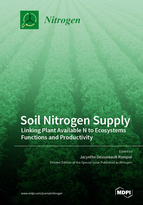Soil Nitrogen Supply: Linking Plant Available N to Ecosystems Functions and Productivity
A special issue of Nitrogen (ISSN 2504-3129).
Deadline for manuscript submissions: closed (31 March 2022) | Viewed by 38836
Special Issue Editor
Interests: sustainable agriculture and climate change; C-N-P cycling in soils; soil-plant relationship; cultivated peatland conservation
Special Issues, Collections and Topics in MDPI journals
Special Issue Information
Dear Colleagues,
Nitrogen, the most limiting nutrient for crop production, has been heavily studied in the last few decades across the world. Although most soils contain a large quantity of organic N, only a small portion is biologically active or subject to solubilization process and will be susceptible to contribute to the so-called soil nitrogen supply of a soil. For agroecosystems as well as for natural ecosystems, this soil nitrogen supply is critical for plant growth and productivity.
Although the scientific community has made outstanding achievements in the field of the soil N cycle, there is still a lack of understanding in how plant-available N is generated, but most importantly, in the understanding of what exactly is plant available N. In the upcoming Special Issue of Nitrogen, titled “Soil nitrogen supply: linking plant available N to ecosystems functions and productivity,” we welcome scientific works (original research papers, field trials and case studies, methods, modeling approaches, and reviews) from a broad scope of disciplines ranging from soil nutrient management, to soil nutrient cycling and soil microbiology and biochemistry, to highlight recent advances on defining and refining concepts and understandings about the soil nitrogen supply and its link to plant available N, ecosystems functions, and productivity. Interdisciplinary works are highly welcomed. We aim to highlight original research approaches and to contribute to the successful expansion of knowledge on the soil nitrogen processes and functions through innovative works that are looking beyond traditional views on the soil N cycle.
Prof. Dr. Jacynthe Dessureault-Rompré
Guest Editor
Manuscript Submission Information
Manuscripts should be submitted online at www.mdpi.com by registering and logging in to this website. Once you are registered, click here to go to the submission form. Manuscripts can be submitted until the deadline. All submissions that pass pre-check are peer-reviewed. Accepted papers will be published continuously in the journal (as soon as accepted) and will be listed together on the special issue website. Research articles, review articles as well as short communications are invited. For planned papers, a title and short abstract (about 100 words) can be sent to the Editorial Office for announcement on this website.
Submitted manuscripts should not have been published previously, nor be under consideration for publication elsewhere (except conference proceedings papers). All manuscripts are thoroughly refereed through a single-blind peer-review process. A guide for authors and other relevant information for submission of manuscripts is available on the Instructions for Authors page. Nitrogen is an international peer-reviewed open access quarterly journal published by MDPI.
Please visit the Instructions for Authors page before submitting a manuscript. The Article Processing Charge (APC) for publication in this open access journal is 1000 CHF (Swiss Francs). Submitted papers should be well formatted and use good English. Authors may use MDPI's English editing service prior to publication or during author revisions.
Keywords
- soil nitrogen supply
- plant available N
- soil N mineralization
- soluble organic nitrogen
- soil proteins
- rhizosphere N
- soil enzymes






